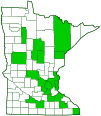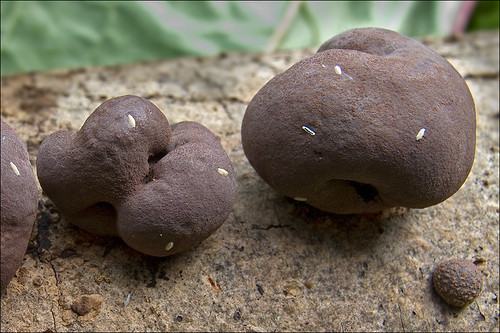King Alfred’s Cakes
(Daldinia concentrica)
Conservation • Description • Habitat • Ecology • Distribution • Taxonomy
|
|
||||||||||||||
Description |
King Alfred’s Cakes is a common fungus that occurs on all continents except Greenland and Antarctica. It grows singly, in groups, or in masses, on dead or dying deciduous wood (saprobic), especially ash. It causes a white rot that produces a condition known as “calico wood”. The fruiting body is ¾″ to 3¾″ in diameter and stalkless. It is usually ball-shaped, sometimes irregularly shaped, especially when growing in groups. When young, it is brown and dense, and it releases asexual spores (conidia) on its surface. The conidia are colorless but may appear whitish when massed. The flesh is dense and purplish-brown. At maturity the surface is black, shiny, and densely covered with minute, pimply bumps. These bumps are tiny, spore-bearing chambers (perithecia) just under the surface. When the spores are mature, the perithecia bursts open during the night, ejecting up to an inch or more large numbers of black spores. These spores are often visible on the bark near the fungus long after they have worn off the fruiting body. Spores are produced from late spring to late fall. King Alfred’s Cakes is long lived and continues growing over several years. Each year a new outer surface is formed. Slicing it vertically reveals black and white concentric rings, each ring representing an entire growing season. The flesh is hard or corky and easily crumbled, becoming less dense as it ages. It is not edible. The spore print is black. A natural spore print can often be seen on the bark near the base of the fungus. |
Similar Species |
Habitat and Hosts |
Dead deciduous wood |
Ecology |
Season |
Year round |
Distribution |
||
|
Sources |
|
| 6/21/2024 | ||
Occurrence |
||
Common and very widespread |
||
Taxonomy |
|
Kingdom |
Fungi (Fungi) |
Subkingdom |
Dikarya |
Phylum |
Ascomycota (Sac Fungi) |
Subphylum |
Pezizomycotina (Sac Fungi and Lichens) |
Class |
Sordariomycetes |
Subclass |
Xylariomycetidae |
Order |
Xylariales |
Family |
Hypoxylaceae |
Genus |
Daldinia |
Subordinate Taxa |
|
Daldinia concentrica ssp. concentrica Daldinia concentrica ssp. intermedia Daldinia concentrica var. concentrica Daldinia concentrica var. pedicellata |
|
Synonyms |
|
Daldinia atra Daldinia concentrica f. confluens Daldinia concentrica f. intermedia Daldinia concentrica var. microspora Daldinia concentrica var. minuta Daldinia tuberosa Daldinia vernicosa f. microspora Fungus fraxineus Gamosphaera concentrica Hemisphaeria concentrica Hemisphaeria tuberosa Hypoxylon concentricum Hypoxylon tuberosum Lycoperdon atrum Lycoperdon fraxineum Peripherostoma concentricum Peripherostoma concentricum var. multicapsulare Sphaeria concentrica Sphaeria concentrica var. pedicellata Sphaeria fraxinea Sphaeria tuberosa Sphaeria tunicata Stromatosphaeria concentrica Valsa tuberosa |
|
Common Names |
|
Coal Fungus Cramp Balls King Alfred’s Cakes |
|
Glossary
Conidium
An asexual spore produced by some fungi. Plural: conidia.
Saprobic
A term often used for saprotrophic fungi. Referring to fungi that obtain their nutrients from decayed organic matter.
Fire Starter
King Alfred’s Cakes is also called Coal Fungus, but not just for its appearance. An older, black specimen, when broken to expose the interior, will readily take a spark from a fire steel. Blow on the glowing spark and it will grow in size. Left alone, it will smolder for a long time. Placed against dry tinder and blown upon, it will ignite a fire.
What’s in a Name?
The common name “Cramp Balls” refers to the belief that when carried in a pocket it can prevent or cure leg cramps. The common name King Alfred’s Cakes refers to a story told about a British monarch. King Alfred fled from a battle and took refuge in a peasant woman’s house. The woman asked him to watch her cakes in the oven. Preoccupied with his own troubles, he let the cakes burn. This earned him a scolding from the woman who did not know her visitor was the king.
Visitor Photos |
||
Share your photo of this fungus. |
||
This button not working for you? |
||
Dan W. Andree |
||
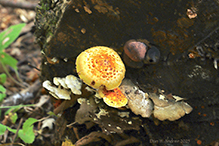 |
||
Paul |
||
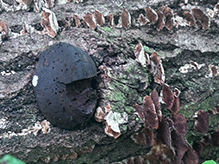 |
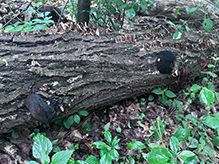 |
|
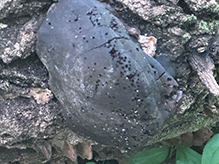 |
||
Luciearl |
||
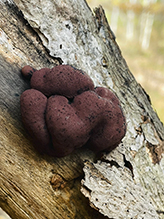 |
||
| Fungi on decaying log. |
|
|
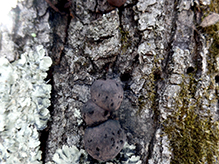 |
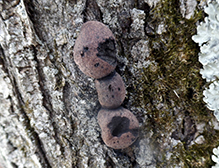 |
|
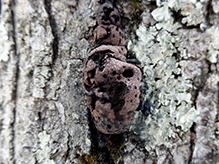 |
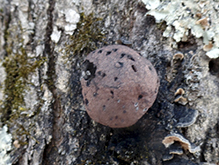 |
|
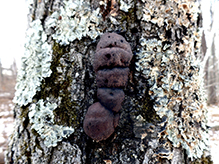 |
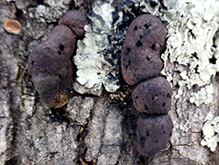 |
|
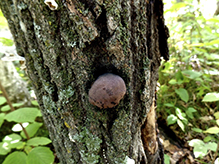 |
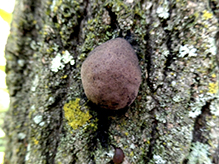 |
|
MinnesotaSeasons.com Photos |
||

Slideshows |
Daldinia concentrica, King Alfred's Cakes or Cramp Balls |
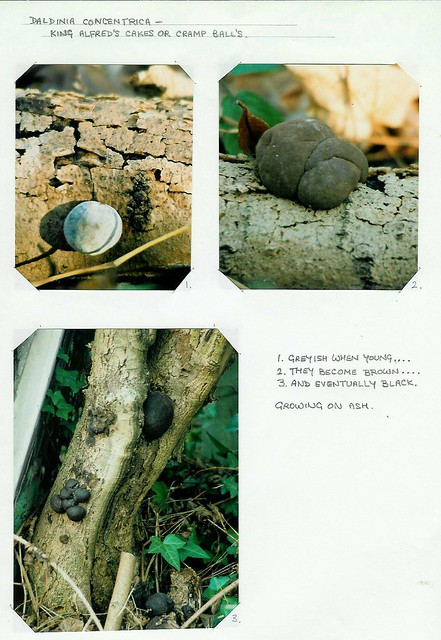
|

Visitor Videos |
||
Share your video of this fungus. |
||
This button not working for you? |
||
|
Other Videos |
||
Daldinia concentrica |
About
Published on Jun 10, 2012 Daldinia concentrica tinder fungus |
King Alfred's cake (Daldinia concentrica) - 2017-04-24 |
About
Published on Jun 29, 2017 The inedible fungus Daldinia concentrica is known by several common names, including King Alfred's cake, cramp balls, and coal fungus. It can be found in North America, South America and Europe, where it lives on dead and decaying wood, especially on felled ash trees. It is a common, widespread saprotroph. Geo location: 51.97683 4.16942 |

Visitor Sightings |
||
Report a sighting of this fungus. |
||
This button not working for you? |
||
| Dan W. Andree 9/17/2025 |
Location: Norman Co. Mn. |
 |
| Luciearl 10/22/2022 |
Location: Lake Shore Fungi on decaying log. |
 |
| Silverwood Gardens September - October 2021 |
Location: Northfield, Rice County, MN At first glance I thought it was scat, but when I picked it up, it was definitely fungi. |
 |
| Luciearl 11/18/2018 |
Location: Fairview Township, Cass Cty. |
 |
| Luciearl 9/26/2018 |
Location: Cass County |
 |
MinnesotaSeasons.com Sightings |
||
|

Created: 11/20/2018 Last Updated: © MinnesotaSeasons.com. All rights reserved. |
